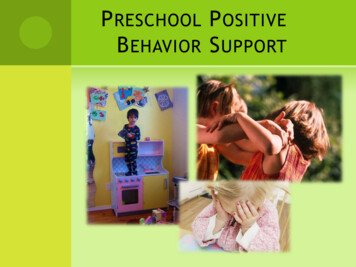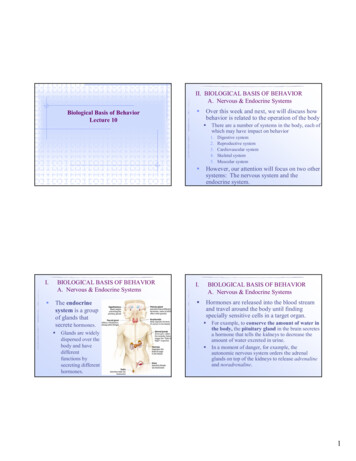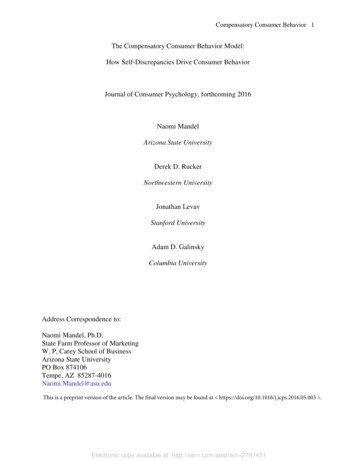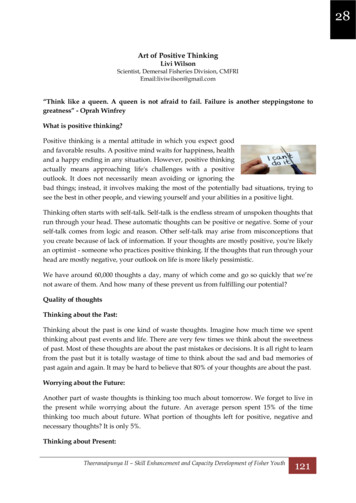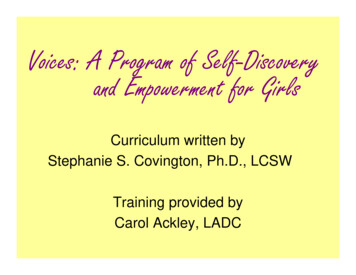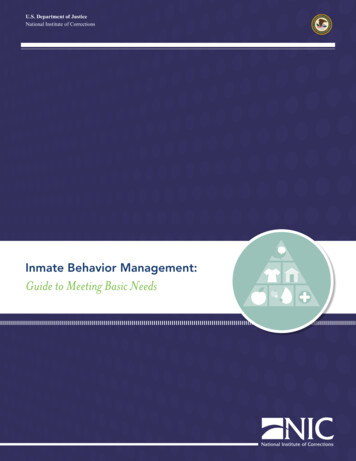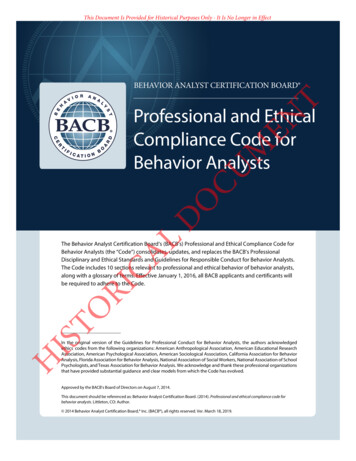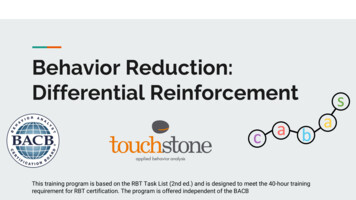
Transcription
Positive BehaviorSupport StrategiesParticipant HandoutDEVELOPMENTAL DISABILITIES SUPPORTS DIVISIONNovember 2019
COURSE AGENDA Course outcomes Key definitions Behavior Intervention Models Behavior is communication Holistic Assessment Lunch General support strategies Human Rights Committees Inclusion of therapy recommendations into the IndividualService Plan Roles and responsibilities for implementation andmonitoring of behavior supports Course evaluationPositive Behavior Support StrategiesNew Mexico Department of Health Developmental Disabilities Support DivisionHandout Packet – November 20191
COURSE OUTCOMESPARTICIPANTS WILL: Understand positive behavior support philosophy Know how to participate in the holistic assessment process Understand the importance of team collaboration andintegration of therapy recommendations into the IndividualService Plan (ISP) Become familiar with general behavior support strategiesPositive Behavior Support StrategiesNew Mexico Department of Health Developmental Disabilities Support DivisionHandout Packet – November 20192
KEY DEFINITIONSBEHAVIOREXAMPLES:IRRITATING BEHAVIOREXAMPLES:CHALLENGING BEHAVIOREXAMPLES:Positive Behavior Support StrategiesNew Mexico Department of Health Developmental Disabilities Support DivisionHandout Packet – November 20193
BEHAVIOR INTERVENTION MODELSBEHAVIOR CONTROLForce and aversive interventions are used to eliminate a targetbehavior.BEHAVIOR MANAGEMENTPunishment and reinforcement are used to decrease or increase atarget behavior.BEHAVIOR SUPPORTHolistic support is provided to address the root cause(s) of a targetbehavior.Positive Behavior Support StrategiesNew Mexico Department of Health Developmental Disabilities Support DivisionHandout Packet – November 20194
BEHAVIOR IS COMMUNICATIONALL people communicate through behavior. So, it is our goal toFIND out what people are attempting to communicate throughtheir behavior.Feelings (Physical & Emotional)Information & IdeasNeeds & WantsDiscomfort & PainWAYS TO FIND OUT WHAT PEOPLE ARE ATTEMPTING TOCOMMUNICATEPositive Behavior Support StrategiesNew Mexico Department of Health Developmental Disabilities Support DivisionHandout Packet – November 20195
HOLISTIC ASSESSMENTWHAT IS A HOLISTIC ASSESSMENT?WHAT IS YOUR ROLE IN THE HOLISTIC ASSESSMENT PROCESS?ASSESS THE FOLLOWING AREAS: Physical health/medical conditions Mental/emotional wellness Cultural and spiritual factors Sexual and relationship issues Environmental factors Function(s) of behaviorPositive Behavior Support StrategiesNew Mexico Department of Health Developmental Disabilities Support DivisionHandout Packet – November 20196
HOLISTIC ASSESSMENT:PHYSICAL HEALTH/MEDICAL CONDITIONSAlways assess for pain or physical illness first when achallenging behavior occurs, especially if the person hasno formal communication system that they usespontaneously and consistently.Ryan & Sunada (1997) found in their study that 75% of people referred to thembecause of challenging behavior actually had a medical problem as the root cause ofthe challenging behavior.SOME SUGGESTED SUPPORT STRATEGIES An appointment with the person’s physician/specialist should bescheduled to seek appropriate diagnosis/intervention. Share results with the person’s interdisciplinary team (IDT), and ensurethat appropriate follow-up actions occur. Exhaust the possibilities, remembering that a second opinion may benecessary. Support the person to increase communication skills so that he/she canclarify how he/she feels (e.g., develop a 24-hour communication system).Source: Zuckerman, B. (1999). “A Positive Team Approach to Development of Behavioral Supports.”Positive Behavior Support StrategiesNew Mexico Department of Health Developmental Disabilities Support DivisionHandout Packet – November 20197
HOLISTIC ASSESSMENT:Mental/Emotional WellnessREMEMBER:We all experience emotions such as sadness and anxiety. This does not mean, of course,that we all have mood disorders or anxiety disorders. Similarly, many people may havecharacteristics such as compulsivity or rigidity (e.g., maintaining a very neat house andgetting upset if someone comes in and messes it up), but this does not necessarily meanthat they have obsessive-compulsive disorder.In order to be diagnosed with a specific disorder/condition, a person has to meet specificcriteria (as determined by appropriate licensed personnel). As a general rule, the personwill have difficulty functioning in day-to-day life.SOME SUGGESTED SUPPORT STRATEGIES Consider life changes that have occurred (e.g., a recent death, moving to a newhome). Some people just need extra time and support to adjust to a new situation. Consult with the team to determine when it is necessary to have a qualifiedprofessional conduct an assessment. Based upon the assessment, a support plan should be developed (with inputprovided by team members). However, it is important for team members tounderstand their appropriate roles (e.g., unlicensed personnel may not know aboutselecting appropriate strategies to use with someone who has borderline personalitydisorder). Psychotropic medications can help people deal with specific mental healthconditions; however, medications are to be used as a support (not as chemicalrestraints). Also, it is important to remember that a medication can actually lead tothe occurrence of challenging behaviors and other complications (e.g., head bangingdue to headaches, which could be side effects). Teams should always proceed withcaution and make referrals to the Human Rights Committee (as needed and asrequired by state policies). Team members must follow the support plan that is developed. It is not possible todetermine if a plan is appropriate if it is not being followed! In addition, rememberthat it is not appropriate for team members to select and implement their ownbehavioral support interventions in isolation. Accurately document your observations and maintain open lines of communicationwith all team members.Source: Zuckerman, B. (1999). “A Positive Team Approach to Development of Behavioral Supports.”Positive Behavior Support StrategiesNew Mexico Department of Health Developmental Disabilities Support DivisionHandout Packet – November 20198
HOLISTIC ASSESSMENT:Cultural/Spiritual FactorsPROVIDE YOUR PERSONAL DEFINITION OF THE FOLLOWING TERMSCULTURESPIRITUALITYSOME SUGGESTED SUPPORT STRATEGIES Learn about the person’s cultural background, including personal beliefs,values, traditions/celebrations, language preferences, racial/ethnicheritage, etc. Discover the person’s definition of spirituality (which may or may notinvolve an organized religion, specific doctrine, etc.). Ensure that the information you discover is documented in appropriateplaces (e.g., in the Individual Service Plan) and that adequate supportplanning occurs. Avoid imposing your cultural values, beliefs, etc. onto the person. Andsupport the person to explore his/her own spirituality. If you feeluncomfortable, talk to your supervisor. Teach the person about his/her rights and responsibilities. It isimportant that the person’s rights are honored (as much as possible).However, with rights come responsibilities. This involves exercisingrights (with safety nets in place) and not violating the rights of others. Seek technical assistance when the team is having difficulty supportingthe person with his/her cultural and spiritual values, beliefs, preferences,etc.Positive Behavior Support StrategiesNew Mexico Department of Health Developmental Disabilities Support DivisionHandout Packet – November 20199
HOLISTIC ASSESSMENT:Sexual and Relationship IssuesHOW DO YOU DEFINE THE FOLLOWING?SEXUALITYMEANINGFUL RELATIONSHIPSSOME SUGGESTED SUPPORT STRATEGIES Ensure that a plan is in place to support the person in the areas ofsexuality and relationships. This may involve several differentcomponents (e.g., a determination of the person’s ability to give informedconsent, level of support needed by staff, specific relationship outcomesand action steps related to the person’s vision). Help the person obtain specific skills and supports so that his/herrelationships can be successful. Examples include the following:o Communication skills (e.g., proper etiquette);o Anger management skills;o Education about relationship (e.g., how to set realistic expectationsand goals), sexuality, contraception, sexually transmitted diseases,childrearing, domestic duties, money management, etc.; ando Support from natural (e.g., family), community (e.g., public healthclinic), and specialized resource networks (e.g., behavior supportconsultant). Build safety nets so that the person can develop meaningful relationshipswith others as freely as possible.Positive Behavior Support StrategiesNew Mexico Department of Health Developmental Disabilities Support DivisionHandout Packet – November 201910
HOLISTIC ASSESSMENT:Environmental FactorsEXAMPLES OF ENVIRONMENTAL FACTORS THAT CAN AFFECT BEHAVIORSOME SUGGESTED SUPPORT STRATEGIES Analyze the environments in which the person does and does not havechallenging behaviors, and try to determine likes, preferences, dislikes, andnon-negotiables.Remember that behavior is a form of communication. “Listen” to verbal andnonverbal messages, and ensure that the person’s communication dictionary isupdated, as necessary.Try to change or fix the situation, not the person!Ensure that team members collaborate to identify appropriate strategies (e.g.,occupational therapist consults with behavior therapist and direct supportstaff).Teach the person effective coping skills (especially when environmental factorsare truly unavoidable), and increase the person's ability to communicateproblems and to get help.Advocate for the person when you hear program-centered statements:o “He has to stay in this home because there are no other placementsavailable.”o “We are not going to change the program just for her.”o “It took too long to get him this job, so he needs to keep it, even if it is toocrowded.”o “We can’t take her out into the community that often, only two times permonth.”Positive Behavior Support StrategiesNew Mexico Department of Health Developmental Disabilities Support DivisionHandout Packet – November 201911
HOLISTIC ASSESSMENT:Functions of BehaviorSOME KEY QUESTIONS TO CONSIDER: What is the person trying to communicate?Why is the challenging behavior occurring now?What purpose does it serve right now?What does the person "get" as a result of the behavior withoutintervention?SOME COMMON FUNCTIONS OF BEHAVIOR: To communicate pain, discomfort, frustration, pleasure, etc.To avoid or escape something/someoneTo stimulate the central nervous systemTo get attention or other social functionsFor revenge and/or retaliationTo provide entertainment/to escape boredomSOME IMPORTANT POINTS: When people have their needs met, it is less likely that theywill engage in challenging behaviors. It is important to teach new skills that are as effective or moreeffective than existing methods of getting needs met. Make sure the new method of communication is successful. Ifthe new skill does not result in at least the same level ofsatisfaction, it may not be useful.Positive Behavior Support StrategiesNew Mexico Department of Health Developmental Disabilities Support DivisionHandout Packet – November 201912
General Support Strategies:Reducing Instances of Challenging BehaviorPROACTIVE STRAEGIES TO DECREASE THE LIKELIHOOD THATA PERSON WILL ENGAGE IN CHALLNGING BEHAVIOR:WHAT ARE SOME STRATEGIES THAT WOULD HELP SOMEONEYOU SUPPORT FEEL COMFORTABLE AND SAFE?Positive Behavior Support StrategiesNew Mexico Department of Health Developmental Disabilities Support DivisionHandout Packet – November 201913
General Support Strategies:Things To Do & Things To AvoidWE ALL HAVE THE ABILITY TO INFLUENCE THE BEHAVIOR OF OTHERSTHROUGH OUR INTERACTIONS WITH THEM.FACTORSPOSITIVE IMPACTNEGATIVE IMPACTPhysical presence andappearancePersonal space andboundariesBody positioningGestures and bodylanguageEye contact and facialexpressionsTone of voiceSpoken and writtenwordsOtherPositive Behavior Support StrategiesNew Mexico Department of Health Developmental Disabilities Support DivisionHandout Packet – November 201914
General Support Strategies:When a Person has Escalated and May Cause Harm Stay Calm. Become conscioulsy aware of your own thoughts, breathingpace, body movements, facial expressions, etc. Treat the person with dignity and respect. Examples of appropiateinteractions include: Address safety issues as soon as possible (e.g., dangerous objects areremoved, other people in services leave the area). Follow specific strategies described in the person’s Positive BehaviorSupport Plan and Behavior Crisis Intervention Plan (as appropriate).SOME KEY POINTS TO REMEMBER: If you are not calm, ask a trained staff member to assist you. Also, if younotice that another staff person is not calm,you should offer support.Having an inconspicuous “SOS” signal can be helpful (e.g., “Hey, Ron, youhave an important phone call to return.”). Some people only need space and time to calm down. Safety for all is your main goal when a person has escalated to the pointof causing harm. It is a violation of a person’s legal rights to use physical restrainttechniques unless it is a true emergency siutation! Also, you should becertified before using physical intervention techniques.Positive Behavior Support StrategiesNew Mexico Department of Health Developmental Disabilities Support DivisionHandout Packet – November 201915
General Support Strategies:Crisis ResponseWHEN A CRISIS OCCURS . . . Continue to follow the strategies listed on the previous handout(e.g., stay calm, treat the person with dignity and respect, addresssafety issues, follow the crisis intervention plan). Use the least restrictive intervention necessary to keep everyonesafe. Physical restraint is a last resort! Be prepared to report and document the incident in accordancewith state regulations, agency policies, and IDT expectations.WHEN WOULD YOU ACCESS EMERGENCY SERVICES DUIRNG ACRISIS?Positive Behavior Support StrategiesNew Mexico Department of Health Developmental Disabilities Support DivisionHandout Packet – November 201916
Human Rights Committees:Review of Positive Behavior Support Plansand Behavior Crisis Intervention PlansUsing the “Human Rights Committee” excerpt in the resource packet, answerthe following questions:1. What agencies are required to have a Human Rights Committee?2. Who is invited to participate in the review of a behavior support plan?When are people invited?3. When do Positive Behavior Support Plans (PBSP) and Behavior CrisisInterventions Plans (BCIP) need to be reviewed? Are they only reviewedthe one time?4. What are three interventions that need to be approve by the HumanRights Committee?5. What are three interventions that HRC are prohibited from approving?Positive Behavior Support StrategiesNew Mexico Department of Health Developmental Disabilities Support DivisionHandout Packet – November 201917
Inclusion of Therapy RecommendationsInto the Individual Service PlanRelevant recommendations (designed to promote effectivecommunication, active participation, health and safety, desired qualityof life, and achievement of meaningful/personal outcomes) need to beincorporated into appropriate sections of the individual service plan.SOME STRATEGIES TO PROMOTE INCLUSION OF THERAPYRECOMMENDATIONS INTO THE ISP Support team members to learn about the “whole person” (including past history, likes, dislikes,preferences, dreams, skills, challenges, etc.). Explain to all team members the importance of participating in the entire ISP meeting,especially during the vision analysis discussion. Help all team members understand their role as consultants and collaborators. All teammembers should collaborate, using their knowledge and expertise, to identify safe and effectivesupport strategies. Consider the following perspectives related to planting a garden: oBEHAVIOR SUPPORT CONSULTANT: Any task could trigger specific behavioralissues. Think about specific concerns related to this activity (e.g., gardening tools maybe potential weapons for some people; planting a garden may actually be a calmingactivity when the person is escalated).oOCCUPATIONAL THERAPIST: Planting a garden involves tasks that require finemotor skills (e.g., placing seeds in the correct spot). In addition, the person may benefitfrom special adaptations and equipment (e.g., built-up handles for tools).Environmental and sensory issues may also need to be addressed.Get team members to think about what they can do to support the person to reach his/her vision.This will involve collaboration (e.g., direct service agency staff consult with the behaviortherapist when developing the strategies for action steps).Positive Behavior Support StrategiesNew Mexico Department of Health Developmental Disabilities Support DivisionHandout Packet – November 201918
Some Key Roles and ResponsibilitiesFor Implementation and Monitoring of Behavior Supports ALL TEAM MEMBERS:Participate in the assessment process.Collaborate during the development of behavioral intervention strategies.Ensure that the relevant regulations, standards, and policies are followed.Present information to the Human Rights Committee, as necessary.Implement the ISP and the various support plans consistently!Maintain open lines of communication.Meet with the rest of the team to address issues, concerns, and complete all assigned actionitems.Advocate for the person.Document what occurs. DIRECT SUPPORT STAFF AND DIRECT SUPPORT SUPERVISOR:Pay close attention to what occurs before, during, and after incidents.Complete data collection sheets and other documentation, as appropriate.Report what occurs. CASE MANAGERFacilitate and/or co-facilitate meetings.Ensure that meeting minutes are disseminated and that action items are completed.Coordinate all necessary services to the support plan.Promote collaboration and integration of therapy recommendations into the ISP.Monitor the appropriate provision of services. BEHAVIOR SUPPORT CONSULTANTUse clinical expertise to conduct a holistic behavioral assessment of a person referred forservices (via formal and informal assessments).From the information collected, develop the behavior support plan and crisis interventionplan.Design data collection procedures.Ensure that team members receive copies of the plan.Train team members (on plans, data collection, etc.), as required by the IDT.Monitor progress and report quarterly.DIRECT SUPPORT SUPERVISOR AND/OR SERVICE COORDINATOREnsure that plans are reviewed by a Human Rights Committee.Ensure that direct support staff members receive individual-specific behavioral supportstraining.Verify that plans are being implemented by direct support staff.Assist direct support staff in documentation of information required by the case manager,behavior support consultant, and other professionals.Ensure that needed documentation (e.g., tracking sheet) is sent to appropriate teammembers.REMEMBER TO ACCESS TECHNICAL ASSISTANCE, AS NECESSARY.Positive Behavior Support StrategiesNew Mexico Department of Health Developmental Disabilities Support DivisionHandout Packet – November 201919
Positive Behavior Support Strategies New Mexico Department of Health Developmental Disabilities Support Division Handout Packet – November 2019 1 COURSE AGENDA Course outcomes Key definitions Behavior Intervention Models Behavior is communication Holistic Assessm

